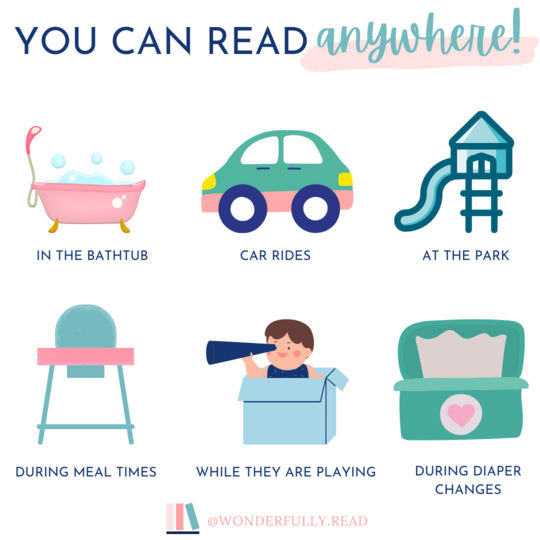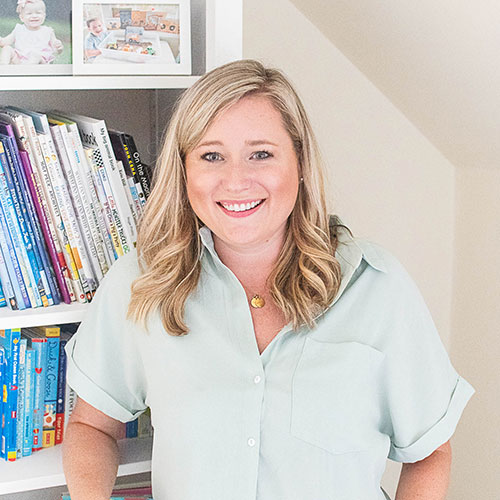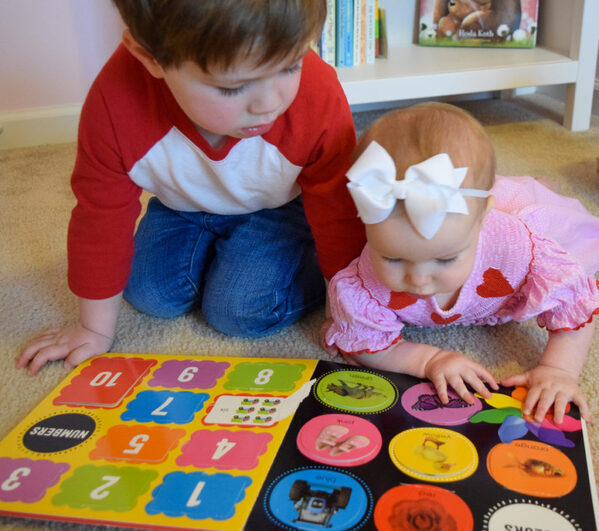It’s no surprise that the research supports reading with you babies from infancy. When babies are read too, they are exposed to more words which helps develop their language skills. When babies are read to from an early age, they are more likely to have stronger vocabularies and literacy skills when they are preschoolers and older. Reading to babies that are on the move (crawling, walking, scooting) add a little extra layer of difficulty. As a newborn, it’s easier to snuggle up and read a few pages together but once they start discovering the world around them, it’s a whole new world to compete with. We want to make reading the number one choice from the beginning! Here are my favorite ways to engage busy babies in reading!
TOP 10 TIPS FOR READING WITH A BUSY BABY!
Face Your Baby While You Read
They will LOVE seeing your face as you make different expressions while reading. This not only boosts language development and vocabulary skills but it also introduces them to different emotions.
Choose Interactive Books
Reading books with lift the flaps and different textures give the element of surprise and will keep you baby engaged. Your child will love opening the flaps, touching something different and experiencing the book with multiple senses.
A Little Goes A Long Way
You don’t have to spend an entire book or 20 minutes reading with your baby. The average attention span of an 8 month – 15 month old is only 1-2 minutes! So grab a book for a minute, read a fun page and then move on to something else! Then, come back to it! It’s perfectly normal for a busy baby to not want to stay still and listen to an entire book!
Add In Movement and Sound
I love reading Moo, Baa, La, La, La by Sandra Boynton because it lends itself to making fun animal sounds! This book still keeps my 2 year old engaged and repeating the sounds! When adding sounds or reading the sounds in a fun way, it catches baby’s attention! This is also a great way to help their language development! By adding movement, for example, pretending to run in place when the character is running, also really engages your baby and makes it a fun experience!
Board Books
Babies take in the world through all their senses, including taste! It’s not surprising that your baby wants to gnaw on the books you are reading! By choosing board books, your baby can help your child learn to love books from the beginning! Board books also help babies learn turn pages because they are thick and easy to turn without ripping!
Sing and Read!
I have the hardest time remember nursery rhymes and baby songs by heart so I LOVE to use nursery rhyme books with babies! These books usually have multiple nursery rhymes and songs for you to enjoy with your little one! Don’t worry if you aren’t a Mariah Carey…I can’t carry a tune and my kids still love to listen to me sing to them (for now! :)) My favorite book with nursery rhyme is “The Big Book of Nursery Rhymes” by Felicity Brooks.
Never too Early for Nonfiction!
So many wonderfully board books are also nonfiction! This is a perfect age to introduce nonfiction because they are starting to notice and discover the world around them. If you are going on your first trip to the beach, grab some nonfiction books with sea animals or about the beach. One of my favorite nonfiction books for this age is My Big Animal Book by Roger Priddy. Think about things that your child seems interested in…pets, animals, the park, food, trucks, cars, trains…anything and you can grab a nonfiction board book for them to begin learning about the world around them!
Read All Around the House
Reading doesn’t just have to happen at bed time or sitting on the couch…it can happen anywhere! Here are my favorite places to add book baskets so we can read anywhere!
Books with Real Photographs or Familiar Things
Babies love to see pictures of other babies. We love Making Faces by Abrahams Appleseed. There are other books in that series, too that are wonderful! Babies also like books that have familiar routines. The Lovevery Subscriptions come with a board book that is perfect for familiar things (like playdates, emotions/faces, parts of the body).
Point out Pictures
Like I said earlier, you do not have to read every single word! Sometimes it’s fun to just grab a book and look at the pictures. By pointing to the pictures and describing what you see to your baby will hear so many new words that will help their vocabulary development. Most board books and books created with babies in mind and they do not have a lot of text on each page so use it as a talking point and describe what you see!



